Clumping Cat Litter with Sodium Bentonite Is NOT Safe for Your Cat

Is Sodium Bentonite Clumping Cat Litter Killing Your Cat?
Update: October 11, 2016
Just noticed someone has referred to this post in a forum: “…says that there’s no evidence that using bentonite clay litter is harmful for cat and humans health, but it’s best to avoid it“.
Let’s clarify our stand with regard to using sodium bentonite clumping clay litter since, evidently, it is not clear enough.
We do not say ‘best to avoid’.
We strongly recommend that you avoid any clumping litter that has sodium bentonite as one of its constituents.
- There’s compelling anecdotal evidence that sodium bentonite clumping cat litter is extremely dangerous for cats, especially kittens and smaller varieties of cats.
- There’s not enough ‘evidence’ that this is so because no studies have been done on its harmful effects.
- To clarify: the lack of evidence is because of an absence of studies, not that there have been studies which were able to disprove this particular litter’s harmful effects.
- Manufacturers dismiss the anecdotal evidence citing more anecdotal evidence (!) and making evasive comments.
- Please feel free to read the rest of the article now – we have cited sources and tried, as far as possible, to NOT make this a mere opinion piece.
AN APPEAL TO OUR READERS:
EMPATHY has rescued and sheltered more than a hundred cats and dogs since 2002.
Cat litter manufacturers cannot possibly be unaware of the dangers that sodium bentonite cat litter poses to cats. If there’s one thing you can be sure of, it is that cats will lick themselves after using the bentonite clay because this clumping variety of litter will stick to their paws. Every time your pets visit the litter box, they ingest the cat litter through inhalation and licking.
The litter accumulates in their stomach and swells, forming a hard lump that renders the stomach to the same state as blocked plumbing. The body will try to cleanse itself through repeated bouts of diarrhea during which time the stomach can hardly absorb any nutrient.
Unfortunately, only the diarrhea is diagnosed by most doctors, and medicines are prescribed upon such diagnosis. The patient eventually succumbs to a very painful death.
The only treatment is to remove the cat from the litter, and then to put the patient on holistic treatment using soothing laxatives to get rid of the poison. During this time, it is best to feed homemade chicken or fish broth or stock. If the treatment begins early, recovery is a distinct possibility.

Types of Cat Litter
Currently, apart from the organic varieties, there are three main categories of cat litter: clump, silica crystal and the plastic crystal varieties. The last one is used by Cat Genie automatic litter box and it is reusable (until you have to replace it). The first two types are used by Litter Maid, a Self-Cleaning Litter Box.
Apart from these two leading brands, clump and crystal cat litter are sold by various companies, either as a standalone product or as recommended litter for the specific brand of cat litter box.
If you are looking for a more detailed account, please read all about Cat Litter, its origin and development in the comprehensive guide on our Overview (Home) page.
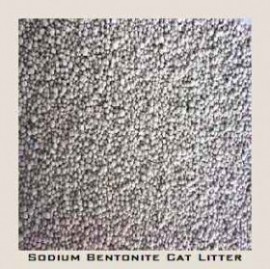
The clump variety of cat litter comes as grainy particles that absorb the liquid from the excreta and also control the odor by forming clumps which can then be scooped out and replaced.
The most powerful clumping substance is Sodium Bentonite, a certain type of clay that swells up to 15 times its volume in the presence of water and is, therefore, extremely effective as cat litter.
Today, more than 50% of the cat litter sold in the U.S. is of the clumping variety, and most of it is made from bentonite clay which is usually procured through surface mining – a process detrimental to the environment. We are warned against flushing sodium bentonite cat litter as the cement like clumping property can block plumbing.
Is there any evidence sodium bentonite litter is bad for cats?
The now defunct Cat Fancy magazine carried an article by A. D. Shojaim, How Cat Litter is Made in its October 1994 issue. The following is an extract:
‘Sodium bentonite, a naturally swelling clay, is often added as an extremely effective clumping agent. When liquid is added, bentonite swells to approximately 15 times its original volume. But because sodium bentonite acts as an expandable cement would, litters containing sodium bentonite should never be flushed; when they expand they can block plumbing.’
Curiously enough, the article made no connection between possible internal blockage that a living being may develop if sodium bentonite litter is ingested. Perhaps, the author did not take into account the possibility that cats could accidentally (while grooming themselves after having visited the litter box) or willfully (as is frequently the case with kittens) ingest this litter.
Voices of dissent against sodium bentonite clumping litter
Marina McInnis, in the January/February 1995 issue of Tiger Tribe: Holistic Health & More For Cats writes about a mysterious disease that kept plaguing (and often killing) her kittens. She finally connects the symptoms to the clumping litter and replaces it with an organic litter. The patients are finally cured through holistic medication.
An updated version of her story may be found here. In her write-up, she refers to Shojaim’s article in Cat Fancy magazine. She also has archived on her site hundreds of letters from cat owners thanking her for saving their cats’ lives through this one article.
But of course, those letters are not scientific evidence and neither is her ‘story’.
It may be pertinent to note in this context that clinical evidence of (suspected) bentonite toxicosis in a cat is published for the first time in the public domain by Marina as well.
May 2000, Annie B. Bond’s article appears on Care2.Com: The Dangers of Clumping Cat Litter.
Stanford University’s eco-advice column answers a query in December 2007 on choosing cat litter. It talks of hazards of sodium bentonite litter and suggests alternatives.
There’s an article on About.Com that speaks at length of problems related to bentonite litter and also refers to Marina’s article as where the dissent originally started. I could not find its date.
In late 2011 I started this blog on my earlier domain kapush.net.
This list is more of a chronology leading to my own efforts than a ‘Further Reading’ section and is by no means exhaustive.
The number one reason clumping clay litter is considered safe
Dr. Elsy’s sums this up with much confidence (under ‘Precious Cat Litter’, Question: “Are clumping litters safe for my cat?”):
Concerns that bentonite clays will “set-up” in a cat’s stomach are un-founded [sic]. Over half of the litters sold today include bentonite clay and have proven safe for cats since their introduction over fifteen years ago. In fact, the convenience of clumping clays have [sic] contributed greatly to the growth of cats as pets. In Dr. Elsey’s 25 plus years as a feline only veterinarian, he has never had a case where clumping litters have caused a problem with a cat.
In other words, there is NO EVIDENCE that sodium bentonite clumping clay litter may be harmful to cats. Anecdotal evidence, of course, doesn’t count.
Interestingly, Dr. Elsy’s says the following to the question “Are your litters flushable?”
No! DO NOT FLUSH our litters. These litters are designed to form hard clumps. A “flushable” clumping litter is a contradiction. If it dissolves or breaks apart in a toilet, it will break apart in a litter box. A true clumping litter is more convenient for you and better for your cat.
Cat’s Pride (a flushable litter that claims not to clump as hard as sodium bentonite litter) echoes Dr. Elsy’s in support of bentonite clay:
Any suggestion that sodium bentonite will cause harm or fluid retention in cats is simply not accurate and has never been documented in the veterinary scientific community. In fact, numerous consultations, interviews, and tests by many vets have found no evidence relating normal use of a clumping/sodium bentonite litter with the sickness or death of any kitten or cat. For additional information visit http://www.sorptive.org/content/index.shtml
Again, there’s NO DOCUMENTED EVIDENCE that sodium bentonite is harmful.
By the way, don’t bother clicking the link at the end of the quote, it leads to a page not found error.
And, of course, without documented evidence, the following cannot possibly be connected:
- Bentonite clay should not be flushed because it is like cement and can block plumbing
- What may happen if a cat’s system tries to ‘flush’ or excrete bentonite litter after eating it
- What may happen if a cat were to eat anything that is cement like
Research on effects of sodium bentonite litter on cats
There’s something interesting going on here.
The absence of documented evidence may imply that research conducted in this area yielded no evidence.
However, there isn’t any research that investigates what happens when cats eat clumping litter.
Anecdotal evidence that sodium bentonite clumping litter is harmful to cats is not acceptable because we need documented evidence.
But anecdotal evidence that no cat has ever been harmed by bentonite litter is more than enough to ‘prove’ that such litter is completely safe.
Just for clarification:
In Dr. Elsey’s 25 plus years as a feline only veterinarian, he has never had a case where clumping litters have caused a problem with a cat.
is anecdotal evidence (and pretty pathetic “research material”).
And
…numerous consultations, interviews, and tests by many vets have found no evidence relating normal use of a clumping/sodium bentonite litter with the sickness or death of any kitten or cat.
is clever evasion.
No one claimed that normal use of any litter ever harmed a cat. Cats ingesting bentonite litter while grooming themselves or kittens playfully eating clumping litter on purpose are not normal uses of cat litter. Yet they happen all the time.
And we are back to where we started in this vicious cycle: there’s only anecdotal evidence of deaths caused by sodium bentonite clumping clay litter.
How can you tell if a litter has sodium bentonite in it?
Some manufacturers clearly state that their products contain sodium bentonite, others don’t. If you find a ‘clumping’ litter which also has the word ‘clay’ somewhere in its list of ingredients, it probably has sodium bentonite in it. When bentonite is not present and the litter is made of clay, you are unlikely to find the clumping property emphasized.
You might also want to read about the few certified organic cat litter brands we have at present.
For more options, explore these Natural Cat Litter choices some of which clump pretty well
Update: August 2016 –
Is Sodium Bentonite Cat Litter Good for anything at all?
Apparently. Bentonite clay and other, similar ingredients found in inorganic cat litter have effectively stabilized and absorbed liquid nuclear waste for years. It is possible that sodium bentonite cat litter has absorbed more ammonia and urea from nuclear waste than it has from kitty pee (!). This came to light after an unfortunate incident at the New Mexico Waste Isolation Pilot Plant (WIPP). Workers had arbitrarily replaced the usual inorganic cat litter with Swheat Scoop which is made from wheat. According to James Conca,
Cat litter has been used for decades in radiochemistry labs and nuclear facilities to stabilize certain radwastes, like liquid scintillation solutions, evaporator bottoms, and other materials that have nitrate salts in solution.
Nitrate salt solutions can ignite when they dry out – which is why it’s tricky working with nitrate solutions in the lab and why you need to make sure they don’t dry out, something many a chemistry student has found out the hard way. So you need to stabilize nitrate solutions before they dry out, or prevent them from completely drying out.
The organic litter was not equipped to stabilize the nitrate salts and dried them to the point of ignition. Well, this was in 2014 and on Valentine’s Day, no less. Thankfully, there were no fatalities and the radiation released was not strong enough to cause environmental concern. WIPP, in spite of performing flawlessly for 15 years, was shut down after the incident and last I heard, it was supposed to reopen this year (2016).
Clumping is not the Problem
Cleaning the litter box and replacing used litter is made extremely convenient if the litter clumps. The problem, therefore, is not the property of clumping but the agent used. This, of course, is easily overcome by switching over to an organic clumping material.
There are a number of organic clump litters available. Natural Wheat Cat Litter from Swheat Scoop is what we can probably vouch for (as long as you promise to NOT use it to absorb anything but feline waste!). Probably, because even though we use wheat chaff, it is not Swheat. We purchase the chaff of wheat from wheat grinding mills in our locality and so far, the stuff has been more than excellent as litter.
The litter ‘box’ in our shelter is basically shallow trenches dug in the ground and filled with sawdust and wheat chaff with a bit of citronella oil thrown in for odor control.
EDIT (May 28, 2017):
One of my readers objected to the use of citronella oil (which is, indeed, toxic to cats if used in large quantities). I’m glad this point was brought up. Here’s a screenshot of the exchange. Click on the image for a larger, readable version. Or scroll down to the comments.
Recycled newspaper, wood shavings, sawdust, wheat chaff – anything organic that will not behave like cement is good litter for your fur baby.
Even silica crystals are not safe and, apparently, they are responsible for affecting the lung tissues of the cat with lesions eventually causing cancer of the lungs or the throat. Please refer to our post on the Problems of Silica Gel Cat Litter if you wish to know more.
You can help to spread awareness by sharing this article using the buttons below.


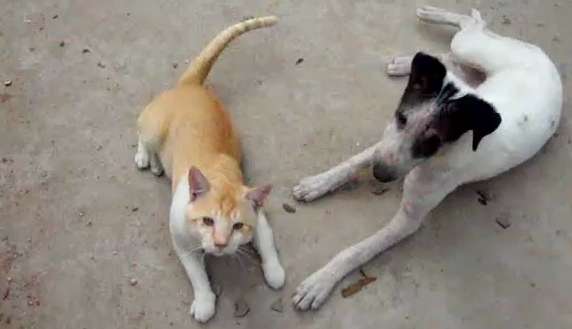

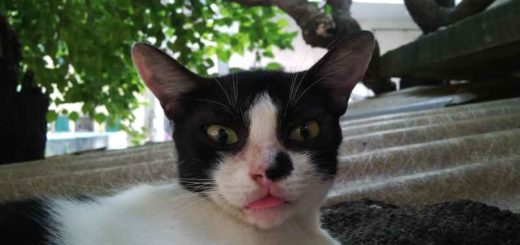

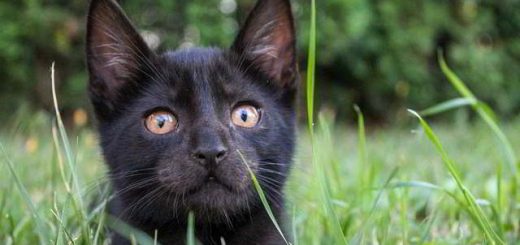


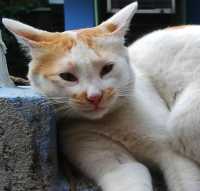
I have been keeping and loving cats all my life. For at least 44 years I have used clumping clay cat litter, even though the modern ones are nicer with smaller particles, they have all worked excellently.
I have always either kept the litter tray/boxes on carpet or used a litter collecting mat to ensure their feet are naturally cleaned of any dust when they leave the litter tray; or a combination of mat and carpet. Perhaps other owners do not do this?
My current two cats are 18/19 year old neutered males, who have lived as house only pets their entire lives. They have reduced appetites… that is normal (for non-greedy) elderly cats. They are arthritic also normal. They are given egg yolk lecithin to assist them in breaking down furballs and one has Lactulose, due to constipation. It is common for elderly cats (and humans) to have bowel issues that cause constipation.
They both had their fill courses of vaccinations as kittens, including the 1st year booster. Since then neither of them has ever needed to see a vet, other than 1 cat developing asthma.
I have never seen grey sludge in vomit or in the litter tray, although I inspect both regularly for any health problems. None of my cats have ever eaten cat litter to the best of my knowledge, and I’m sure I would know if they did.
Perhaps cats are eating the clay because of a lack of something essential in their diets? it’s certainly not something that normal cats do, in mine experience and opinion.
You say anecdotal evidence, i.e. first hand experience, does not count, but it would in a court of law, so why not for you?
I think you are scaremongering unnecessarily as many millions of cats do live with clay cat litter every day of their lives and come to no harm, like mine. If bentonite clay is as dangerous as you and others seem to think, I do not believe that my cats would be as alert, fit, healthy and happy as they are. I would attach a photo if I could.
I feel that perhaps you need to rethink your advice. I don’t think that 44 years of loving and caring for my healthy cats as much as I do is a coincidence or luck. I have never encountered any health problems caused by using the clay cat litter.
What a pompous and self absorbed text. You are either a corrupt employee of a clumping litter company, an equally corrupt vet or just a brainwashedz extremely conformist airhead who is incapable of learning anything outside the bubble. Wake the f up
iI have lost three healthy beautiful fur babies after buying the Bentonite cat litter it took me three deaths to investigate this litter as this was the only change I had made for my babys in years and now it looks like I unknowingly caused their deaths I am totally destroyed over this and something has to be done to get this of the market
Hi angie,
Please forgive me for the terribly late approval. There was a problem with the WordPress notification system and I don’t really monitor this site any longer (but will, shortly).
I am so sorry to hear about your loss. Only way to get this out of the market is to spread the word as much as possible. I do hope time heals you. Best wishes to you and yours …
My cat age twenty started to lose her appetite over the last two months, and then I noticed she started eating the clumping cat litter, and I noticed she started to suffer with constipation, and started to go downhill very rapidly. I took her to the vet and they gave her lactulose, and I carried on administering twice a day 2ml of lactulose.
You would not believe what came out of her. Over a period of five days about a mug full of grey cement sludge and stools were passed. Here colon must have been impacted with litter. She is now on the road to recovery and eating again and looks very happy in herself. I feel that I had a very lucky escape, cat litter or fullers earth could possibly be a killer
Pat.
Mandy – Please do NOT push for these studies because you are in fact asking for numerous kittens to be killed if they do them. Perhaps you do not fully understand what you’re asking for. A study of this nature will involve a study with numerous cats of different ages including a large number of kittens who will be subject to a slow and painful death. This study will require the feline subjects to be gavaged – a tube of the appropriate diameter to necessitate the flow of the material will be jammed down their throats to facilitate the substance in question reaching their stomachs. They will start off with a set amount of litter, then gradually increasing each day until those cats are dead. They may chose to kill and dissect some while allowing others to remain having litter forced down their throats until the amount is increased and death is achieved. Those cats and kittens will suffer terribly. They will not be handled gently. They will receive one iota of love or kindness because the people who work in labs that perform animal studies are known to cruelly abuse and torture these animals. The humans shut down due to the nature of their work and instead of allowing themselves to feel any emotional pain that comes from showing those animals any kindness while at the same time causing such suffering in those animals, they become exceptionally cruel to them. These animals will only know horrible pain and constant fear and abuse from the time they enter that lab until they’re killed by having a pipe roughly rammed down their throat and litter poured down it each day. They may even withhold water from some of them as a facet of the study. You will condemn these kittens to this if you push for this study. This is the reality of EVERY animal study that happens with all products marketed for animals. And many studies are much more horrific than this one would be. Every time a manufacturer markets a new flea product a new group of animals are subjected to similar studies having toxic chemicals poured down their throats, poured into their eyes, etc. How do I know these things? Because I do research. I actually read these studies despite crying so hard I can barely see and it making me physically ill. Every last line, every sickening detail, of every single one of them. I hate reading them. I hate seeing the videos of these animals being tortured and abused, but to ignore them, to look away, to stop reading, is actually worse. People don’t want to know, pet owners don’t want to know what animals go through so we can have products for our pets. But I know what these animals have suffered, and will continue to suffer, that’s why I actively work to try and stop it. — Please don’t ask for animal studies to test products. We have enough products already out there and we don’t need new ones. Many times there is no good reason for these studies, and worse many times with new products the same horrific tests have already been done yet they are repeated. Animal studies are always bad for the animals who are forced to suffer unimaginable horrors and lose their lives through them. It’s unconscionable what they do to these animals in their labs and it has to stop. I urge everyone to bear witness to their suffering and try to do something about it, petition your congressperson for an end to animal experimentation and product testing. And please, please, support an organization working towards ending the suffering of animals in labs everywhere.
Damn. I hadn’t thought about that. And in any case, the end result will probably say that there is no conclusive evidence that clumping litter is unsafe for cats, and so it must be safe. Thanks for pointing this out. Since you’ve addressed Mandy directly, I hope you will have no objection if I quote your entire reply when notifying her of what you’ve said.
I am fostering an 8-month old cat named Fred. One morning he came into the room and said “Wowowow,” and vomited a small amount of brown liquid. He seemed otherwise OK. But he did it the next morning. On
the 3rd morning, I called the veterinarian. After examining him and palpating his abdomen (which he didn’t like), she gave him an enema – and got clumps of litter! Over the next 3 days they gave him subcutaneous fluids and 2 more enemas. So we immediately began searching for another litter. Problem: we have 9 foster cats, and 9 of our own. With non-clumping litters, the boxes need to be changed more often, creating more bags of litter in the garbage. We are limited to 6 bags total. So we are hoping to find a litter where the used material can be removed without removing most of the unused litter.
Hi Judith,
Thank you so much for sharing your experience with us!
In our shelter, at one point of time there were 39 cats. We had a trench dug outside in the open ground filled with sawdust and wheat chaff purchased in bulk. That worked for us.
You can also take a look at this litter – it isn’t cat litter per se, but there are user reviews (including on this site) on how well it works.
Glad the kitty recovered.:)
I’ve used clumping litter for all my cats, and they have never had any health problems relating to digestion. I have never seen the litter kling to the paws or other places on our cats, so when they clean themselves, they will only ingest a tiny amount of dust (as with most types of litter). If the dust expands 15 times, it would still not post a threat to the digestive system, as it’s so small from the start.
If your cat has a tendency to eat litter, like if it’s an inquisitive kitten, I absolutely agree that you shouldn’t use clumping litter, because it seems logical that it’s not healthy or may even be harmful to ingest larger amounts of a substance that expands 15 times its size when in contact with liquid. But as long as your cat doesn’t eat the litter, I can’t imagine that it’s unsafe.
I agree that there seems to be mostly anecdotal evidence on both sides, but because of this I really don’t understand why you would post an article saying basically that clumping cat litter will definitely kill your cat. You should have hard evidence when making such a strong claim. Also, if this was true, almost no person in the world would use it, because everybodys cats would die within weeks from using it. As I wrote in the previous paragraph, if the cat eats the litter, it could probably be dangerous, but most cats don’t do that.
Hi Julie,
Thank you for your comment.
I’m so glad you’ve never had a problem with clumping litter – it is always good to hear about healthy fur babies.
Not everyone has been so fortunate, however. If you scroll down to the first three comments here, you’ll know.
I’m not sure where in the article I wrote ‘clumping litter will definitely kill your cat’. If you could point it out to me – doesn’t have to exact words, if you could point me to where something I’ve written *means* something that extreme, I’d be very willing to revise it.
Regarding your statement about no one in the world using substances that are known to be toxic, yes, very logical, but smokers all over would probably disagree. While on that topic, may I also state that despite the very real dangers caused by smoking, I’ve personally known men and a few women as well, who have lived well into their eighties while still being smokers. But that didn’t make them say smoking was NOT harmful.
Again, I’m happy that your babies are safe.
I wrote the article to let people know the whole truth . It is important to be informed. You may have noticed that I did not exactly write an opinion piece. Everything has been referenced so that those interested may verify the facts as they stand. But without enough articles on this subject, people might not even be aware of the dangers.
Thank you for visiting. I do hope we get to see you again.
Citronella has ketones in it. You should NOT being using it in your “natural” cat litter for scent control. It’s dangerous if ingested. Furthermore, it’s used as a cat deterrent, so I’d be surprised if you’re not making your cats extremely unhappy by forcing them to use litter with citronella in it. I’m not a proponent of clay litter either, but forcing citronella on your cats is not good either. In this case, you’re using your own anecdotal “evidence” that it’s safe when it is not. Please do more research on the subject of citronella since you are claiming you have a “shelter.”
Hello Jennifer,
Thank you for your comment. First, I’m not ‘claiming’ I have a “shelter” – I mentioned it – there’s nothing to ‘claim’.
It began in 2001 and has been in a bad state the last five years since I came into severe financial problems. I’m even considering a fundraiser after having self-funded it for the last 16 years. I’m fortunate to have had animal lovers in our area helping me out all the time, hence ‘our’ shelter, to acknowledge that help.
Citronella is toxic to cats in large quantities (which is the truth about some good medicines as well). Not when sprayed in highly diluted state in a 5′ x 3′ trench full of a mixture of sand, sawdust, and ground garden soil (and some cat poop). I did ask my vet about it (he doesn’t claim to be a vet, either, he IS one).
Citronella does not repel all cats. Please read the comment by Alice McLean at https://www.vetinfo.com/using-citronella-oil-cat-repellent.html
However, I have personally found it discouraging cats from pooping in a neighbor’s lawn when used without dilution.
On a related note, onions supposedly cause anemia in cats. A friend of mine used to feed her cat a herbal soup with onions in it and the cat lived a happy life and died a peaceful, natural death at around 16 years of age. My friend didn’t know of the danger of onions and I did not know about the feeding – no one was doing anything to prove a point, but a point is proved nonetheless: It is best not to generalize.
You don’t ‘force’ cats. To do anything. Period.
If they were unhappy with the scent, they would have pooped elsewhere. There was a lot of open space where the trenches used to be.
However, you raised a useful point and I’m going to add this conversation inside the article as soon as I can.
Thanks again.
My baby girl cat started getting sick less than 24 hours ago, with nausea and dry heaves of yellow foamy liquid. She wont eat or drink and I’m worried about her. I’m staying up all night to watch her and taking her to the vet at sunrise. My nephew brought his cat here 2 weeks ago to stay with my sister and I till August . He brought 2 boxes of clumping cat litter to use. Personally I won’t be scooping out the clumps as , I’m a believer in old fashion litter. I change the litter 3 times a week and clean her box everytime . My sister told me that Panda my cat has been using the new cats box and I didn’t think much of it until today, remembering some info about the clumping litter. I don’t understand that if the sodium bentonite clay is harmful to plumbing turning it into cement, then why is it OK for cats. I know my cat cleans her paws right after using the box. Why do they put a warning out for plumbing and not for cats. Does anyone know the signs and symptoms of Bentonite clay ingestion. I’m so sorry to those who’ve lost their cats as I know animals are our family members too. Michelle
Michelle, I’m so sorry to hear about Panda. My wife had a cat by that name, once. Please consult a holistic vet if you think bentonite toxicity is the problem. I have discussed the symptoms in the article – it appears that your cat has diarrhea but that’s a misleading symptom which leads to wrong treatment. Hope Panda gets better soon …
This is so horrible. We need these studies done! We lost 3 awesome cats since Jan. 1st. 2017. Our pets died from a common product. The clumping cat litter. I feel horrible. I am supposed to keep them safe. I want to get this issue resolved. Please help me, so we can spare other family pets from this terrible neglect. Let’s get these studies started!!! Mandy Cordray cordrayts@gmail.com 217- 828- 1363 text me
Hi Mandy,
Really sorry to hear about your cats. Please share the article and other related material on social media to raise awareness. However, I would advise against putting your email and phone number where anyone can see them.
Hi, My cat started have problems, eg: loose stool; vomiting often with hairballs and then w/o hairballs, but a greyish/yellow frothy substance; wouldn’t eat and had no energy. Took him to the Vet …$$$$. I then read about sodium bentonite on the web. I got rid of both litter boxes of the clumping litter and re-filled with a non-clumping wheat chaff material. My Wife and I force fed our cat a couple of times that evening. I also did a thorough vacuuming and mopping of the floors (I’m retired, but my Wife isn’t so our family responsibilities have changed a good deal). The result was, to say the least, unbelieveable. The next day the cat went to his feed bowl and sat to be fed, as usual. He ate 2 tablespoons of the Vet canned food and hasn’t vomited yet (3 hrs.). GET RID OF YOUR CLUMPING CAT LITTER !!!!!!!!!!! I can’t say this strongly enough. Take care, Rich
Thanks for sharing your experience with us, Rich. And I’m sorry my reply comes so late – haven’t updated or even looked at this blog in ages :p
Hope your fur baby is bouncing around happily, now 🙂